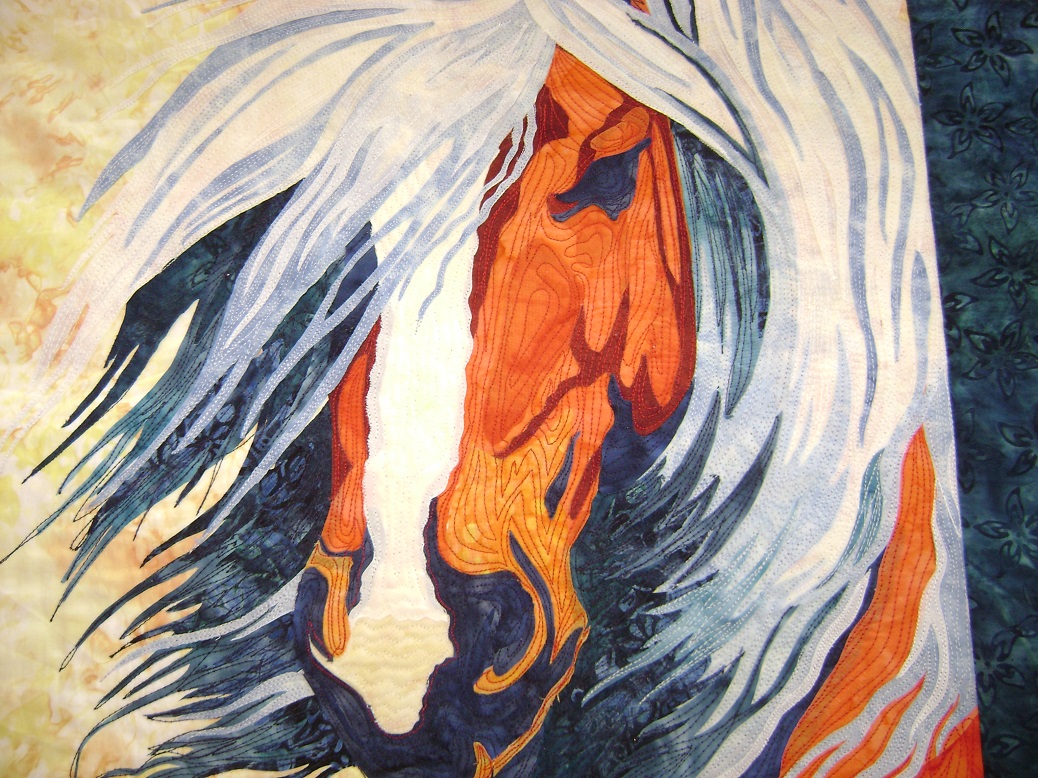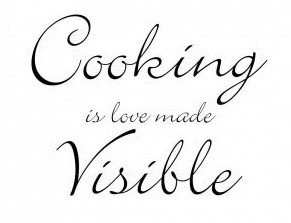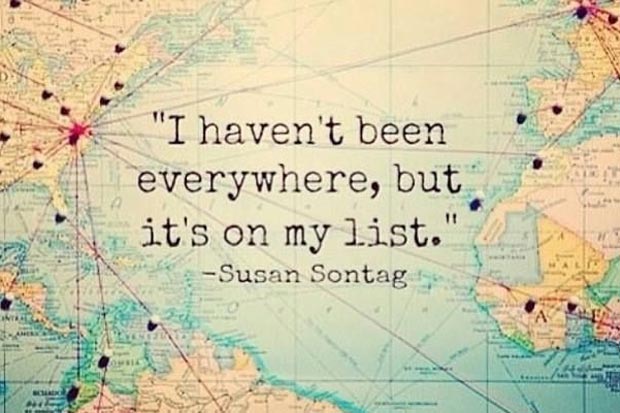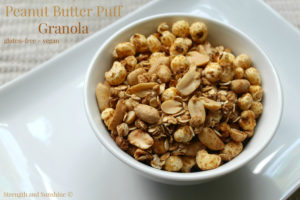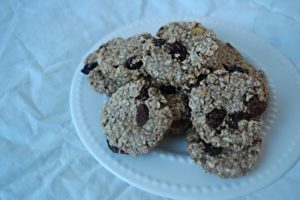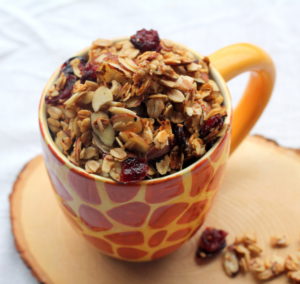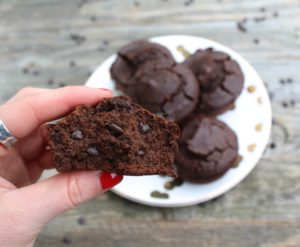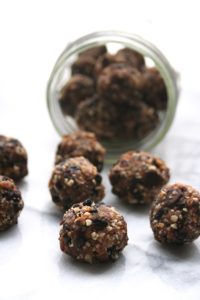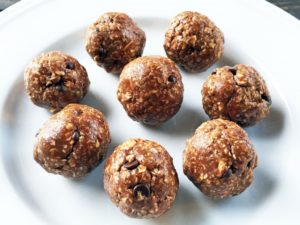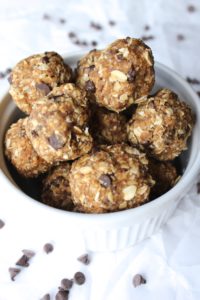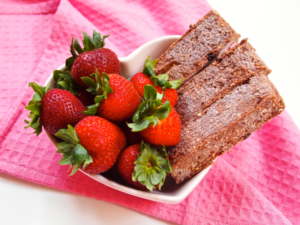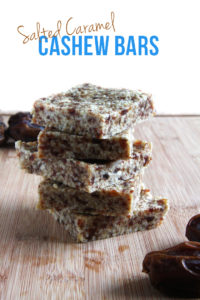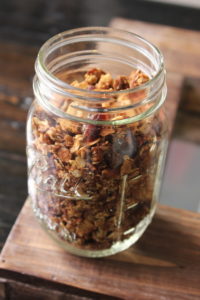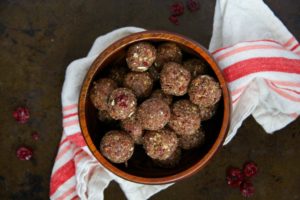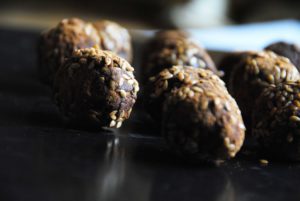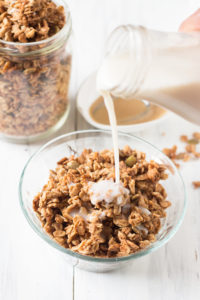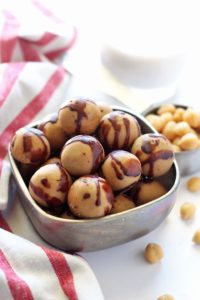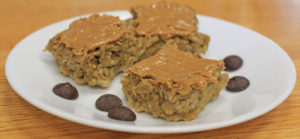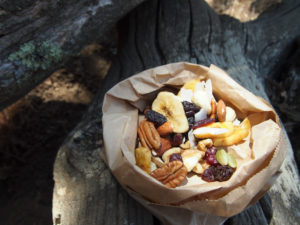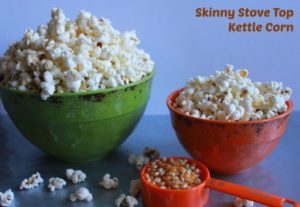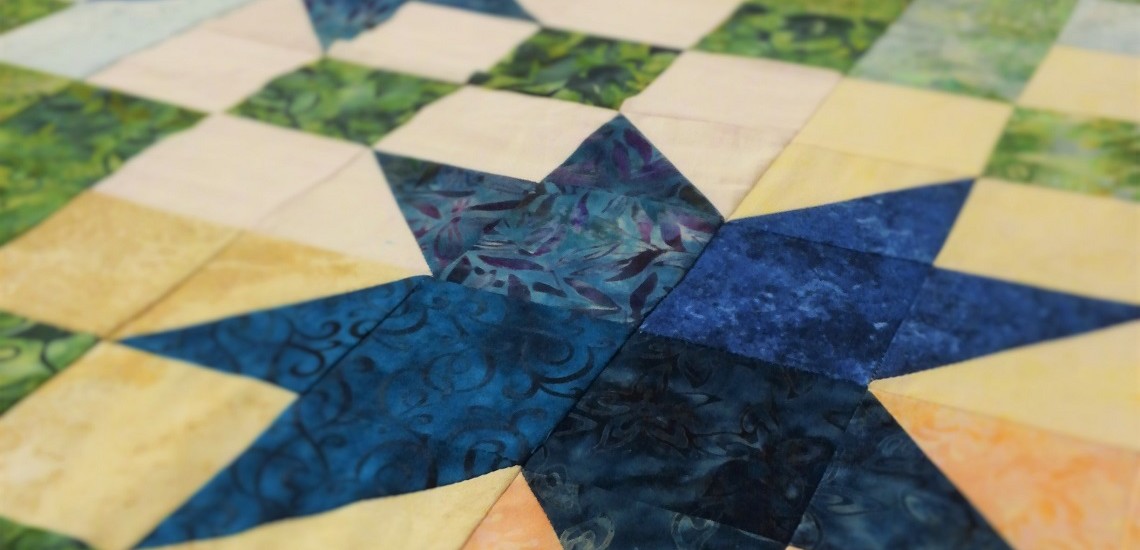
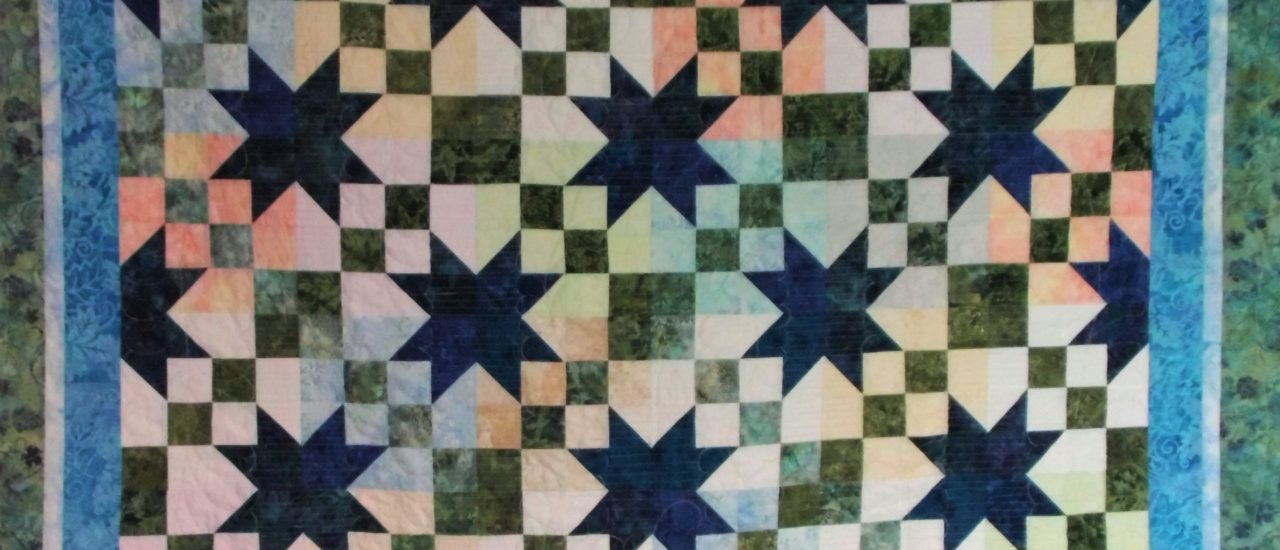
Presenting: Softly Comes the Summer Stars
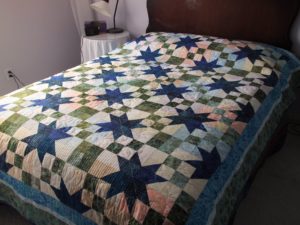
Softly Comes the Summer Stars, 2016
This is actually the 5th quilt in a series that I have made over the last several years.
Inspiration
I first saw this pattern on Craftsy.com. I didn’t buy it, though. This is a fairly simple, traditional pattern – it’s called a “Sawtooth Star”. I don’t like paying someone else just to do the math for me. Besides, calculating the blocks from scratch lets me make the quilt in the size I want, in the colors I want. I am pleased with how this has turned out.
A Series of Quilts
Making a “series” means, in this case, that I cut and sewed enough blocks to make several quilts. And I had plans for all the quilts.
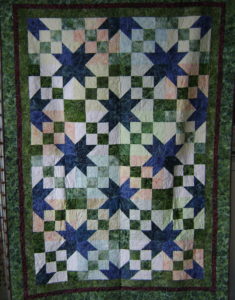
Sawtooth Star I, 2014
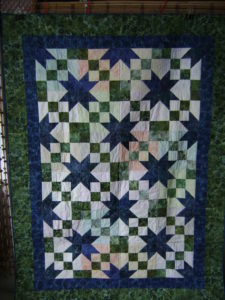
Sawtooth Star II, 2014
The first two quilts were twin sized. They have different borders, but are otherwise virtually identical. Both were donated to Quilts of Valor, an organization that benefits service members and veterans who have been touched by war.
In the process of making these blocks and quilts, I realized that the block I was using was the basic block for the traditional, “Road to Oklahoma” quilt pattern.
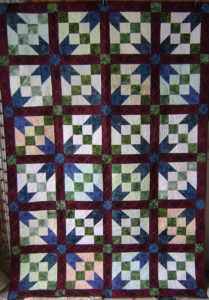
Peter & Melody’s Road, 2014
You can see how adding sashing can really change the look of the pattern! My friends, Peter and Melody, were getting married about this time, so I made this quilt for them. As it happens, they will be hosting me my first night out of Denver on my way to Chicago to drive Route 66! It will be great seeing them and their new baby.
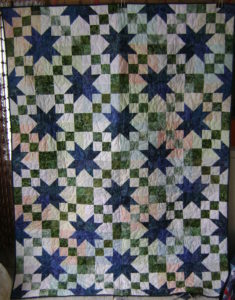
Norma’s Kitty Paw Prints, 2014
The fourth quilt in this series was made for a dear friend. Norma loved cats, so the quilting is an all over design of flowers and paw prints. This quilt was full sized, with no border. At that time, Norma had been diagnosed with cancer – I wanted her to have something she could really wrap around herself. She has since gone to be with Jesus and the quilt was passed to another friend. I really love the idea that my quilts are valued and enjoyed by multiple people.
Softly Comes the Summer Stars
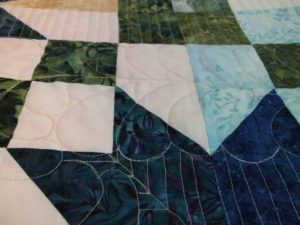
And this brings us to the final quilt in this series. This quilt is joining my own collection. Yeah! I get to keep one of my quilts!
The Craftsy pattern was titled “Under the Stars” and has been fairly popular. That means there are LOTS of quilts out there named “Under the Stars”. I had to find a new name. “Softly Comes…” seemed appropriate as Springtime is ushering the changes from winter to summer.
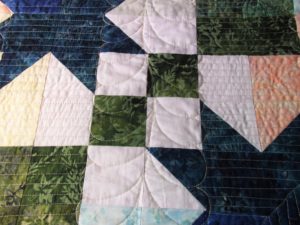
I quilted this with a series of feather “frames” filled with parallel lines. You can read my Tips & Tricks on stitching borders to see more of my border feathers on this quilt.
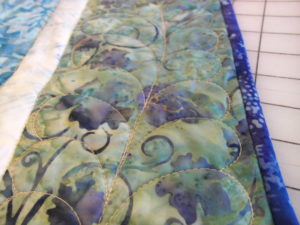
Feathers intact with finished binding
I will soon be driving down Route 66 on an amazing adventure! I am actually bringing my sewing machine along with me. I plan on making blocks along the way to commemorate my trip. Okay, so there’s no guarantee that my sewing machine is taken out of the car at all, but I’ll be prepared anyway! You may recall from my basting post that I have a green/purple quilt ready to be quilted down, too. I have no shortage of projects!
So check back soon to see the latest of what I’m making and baking and all the new sights!
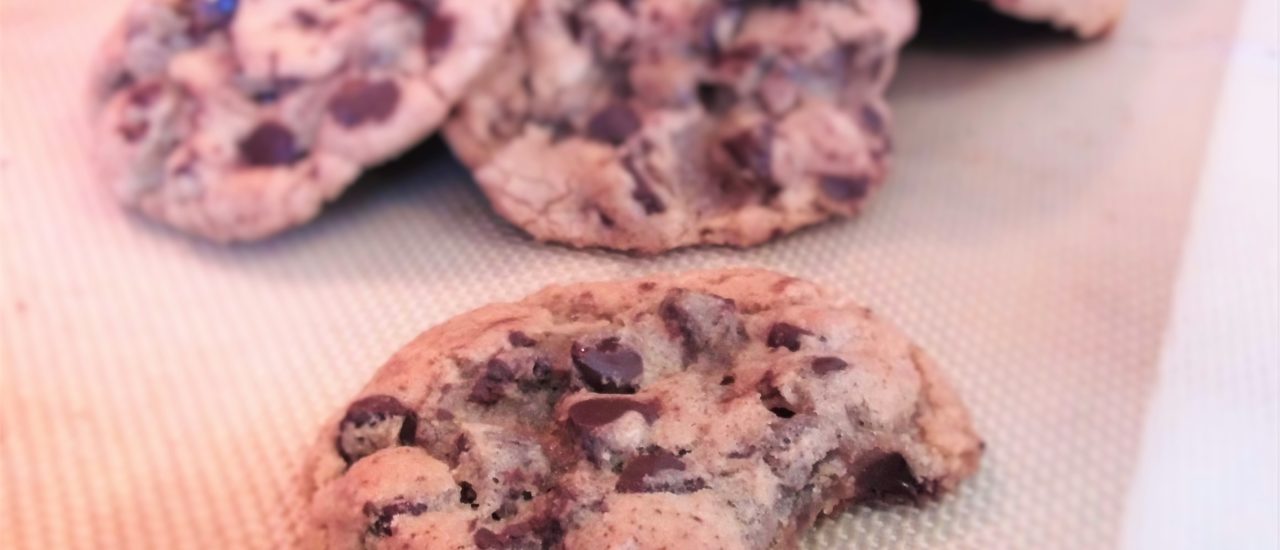
The Art of the Chewy Chocolate Chip Cookie
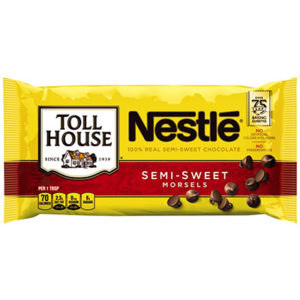 If you click on this picture, you’ll be taken to the “Original Tollhouse Chocolate Chip Cookie” recipe by Nestle. Okay, everyone raise your hand if your mom’s recipe box included the recipe cut off the back of the bag, but your mom used the cheaper, generic chocolate chips. These days we can just google for a recipe – but it never seems quite the same. That’s okay – my purpose in writing this today is to give you a few insights on making your cookies a little chewier and tastier, just like Mom’s.
If you click on this picture, you’ll be taken to the “Original Tollhouse Chocolate Chip Cookie” recipe by Nestle. Okay, everyone raise your hand if your mom’s recipe box included the recipe cut off the back of the bag, but your mom used the cheaper, generic chocolate chips. These days we can just google for a recipe – but it never seems quite the same. That’s okay – my purpose in writing this today is to give you a few insights on making your cookies a little chewier and tastier, just like Mom’s.
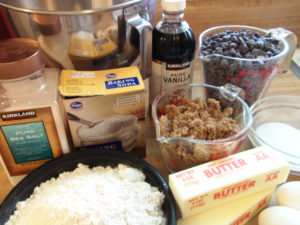
Let’s assemble all our ingredients! Or, if you have a really small kitchen like mine, just clear the counter around your mixer so you have room to work.
A cook is only as good as her ingredients.
Make sure all your ingredients are fresh. I tend to bake in phases – I might go months without baking anything. But when the holidays roll around, you know you’ll find me shifting through my cookbooks to find the perfect cookies for that season. At that point, I’ll be checking the expiration dates on baking soda and baking powder (which has a relatively short shelf life), and always buying fresh flour. A lot of these ingredients are not very expensive – when in doubt, throw it out.
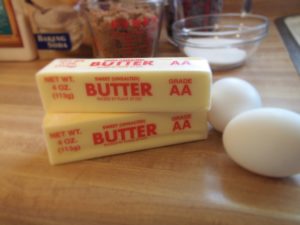
I have no particular preference for salted vs unsalted butter. This recipe is not so sensitive that the salt in a stick of butter will cause it to fall apart. What is important is that you melt the butter before creaming it with the sugars. Some folks will tell you to avoid melting in the microwave, but I haven’t had problems. Whether it’s melted on stovetop or in the microwave, use liquid butter in this recipe.
Eggs vs egg yolks…
What makes this recipe a little chewier and moister is
- There is more brown sugar than white, and
- We threw in an extra egg yolk. Egg whites will add a certain stiffness. Yolks add chewiness.
Now you know.
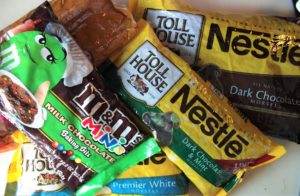
This is not a Nestle commercial! These are just the chocolate chips I happen to have in my cupboard at the moment – they were on sale. You can use any chocolate chips in your cookies – dark, white, M&M’s, caramel, butterscotch. Go for it! Use a mix of different flavors. And use plenty of chips! If your bag is slightly more than what you need according to the recipe – use the whole bag!
Don’t be a skimpy chipper!
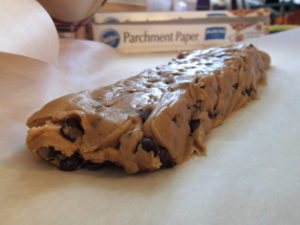
Mixing the rest of the dough is fairly straightforward. Once it’s all together, it’ll be thick and sticky. Drop a third or a half of the dough onto a section of wax paper and shape it into a log. Okay, I know, the picture has parchment paper! That works, too. I think waxed paper releases the chilled dough a little easier. Use whichever you have on hand. The key is to have this log of dough wrapped well and put in the fridge for 2-3 hours. Overnight, if you want.
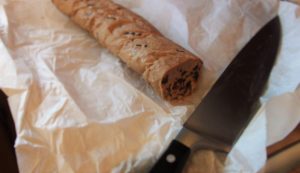
Next up you’ll cut your chilled log into sections.
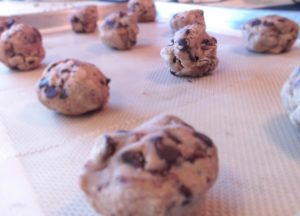
Shape them into balls and space them out on the cookie sheet/pan. I like to use a silicone baking sheet on my pans – makes cleanup a little easier. Or you can use parchment paper (not wax paper!). Or just bake on an ungreased sheet/pan.
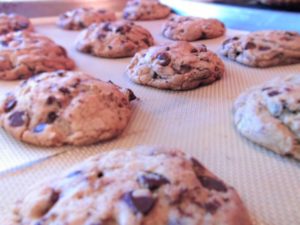
Yes, my friends – these are chewy, puffy chocolate chip cookies baked at altitude, in the Mile High City! It can be done!
“…Every time she puts another batch in the oven
There’s 15 minutes for some kissin’ and a-huggin’…”
— George Straight
Happy baking!
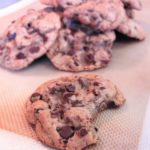
| Servings | Prep Time |
| 2-3 dozen | 15 minutes |
| Cook Time | Passive Time |
| 12 minutes | 3 hours |
|
|

|
These cookies are so chewy and delicious - and easy to make - they will become the staple in your cookie exchange! Best yet, this recipe is already adjusted for high altitude baking. So break out the shoe box, line it with wax paper, and get ready to fill it to the brim!
|
- 2 sticks butter melted
- 1/4 cup white sugar
- 1 1/4 cup brown sugar
- 3 cups all purpose flour dry ingredient
- 1 tsp salt dry ingredient
- 1 tsp baking soda dry ingredient
- 1 egg wet ingredient
- 1 egg yolk wet ingredient
- 2 Tbsp milk wet ingredient
- 1 1/2 tsp vanilla wet ingredient
- 2 cups chocolate chips
- Cream the butter and sugars together.
- Sift together dry ingredients in a bowl - set to one side.
- Add wet ingredients to the sugar/butter.
- Add dry ingredients one cup at a time.
- Add chocolate chips.
- Roll in wax paper and chill in the fridge.
Credit where credit is due: this recipe is a variation on Alton Brown's "The Chewy".
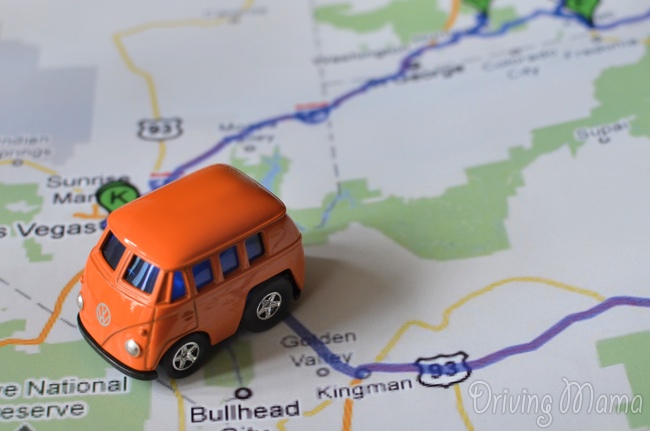
Route 66 – Road Trip Food
(Cover photo borrowed from DrivingMamas.com)
We are getting closer and closer to my GRAND ADVENTURE driving down Route 66. And something that every Road Trip needs is Road Trip Food!
When I was little, our family would go on road trips from Los Angeles to Nebraska or to Minnesota. Being the youngest, I always got the middle of the back seat between my two brothers. Mom always brought veggies and apples and oranges – but I always loved the green seedless grapes! We only had a smallish cooler, and that was needed for the sandwich fixin’s, so our soda pop was usually warm. But the fruit was tasty!
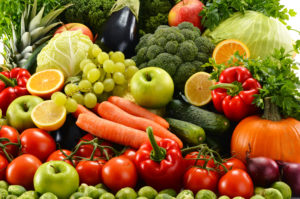
So the first and most important road trip food are the snack packs that God provided! And they all seem to come in convenient serving sized packages.
Yes, I know, you may be thinking that this is the time to break out the candy and cookies! No! It’s not! That sugary food will only cause you to get more tired as you drive and you’ll be less able to enjoy the wonderful world around you. So reach for the natural energy boosters!
For me, I reached out to my blogging community and asked for more ideas of healthy snacks for the road. Here are the suggestions – in no particular order. The last is as tasty as the first! Thanks to all my friends for providing these recipes!
Peanut Butter Puff Granola from StrengthandSunshine.com
Healthy Oatmeal Cookies from Anagoesfit.com
Cranberry Almond Stovetop Granola from FoodPleasureandHealth.com
Healthy Mocha Brownies from TheCleanEatingCouple.com
Chocolate Cherry Larabar Bites from HungryByNature.com
Healthy Chocolate Peanut Butter Energy Balls from AFitPhilosophy.com
6 Ingredient No Bake Energy Balls from PumpkinandPeanutButter.com
Chocolate Covered Strawberry Protein Bars from HealthyHelperBlog.com
Salted Caramel Cashew Bars from 24CarrotLife.com
Coconut Homemade Granola from BerriesandBasil.com.
Cranberry Walnut Energy Bites from EmmasLittleKitchen.com
Chocolate Trail Mix Power Bars from YoungandRungry.com
Coconut Maple Tahini Granola from ExSloth.com
Chocolate Covered Chickpea Protein Balls from EmilieEats.com
Banana Oat Bars from FoodParsed.com
Grant Trail Mix from VermilionRoots.com.
Skinny Stove Top Kettle Corn from EnticingHealthyEating.com
Happy Snacking!
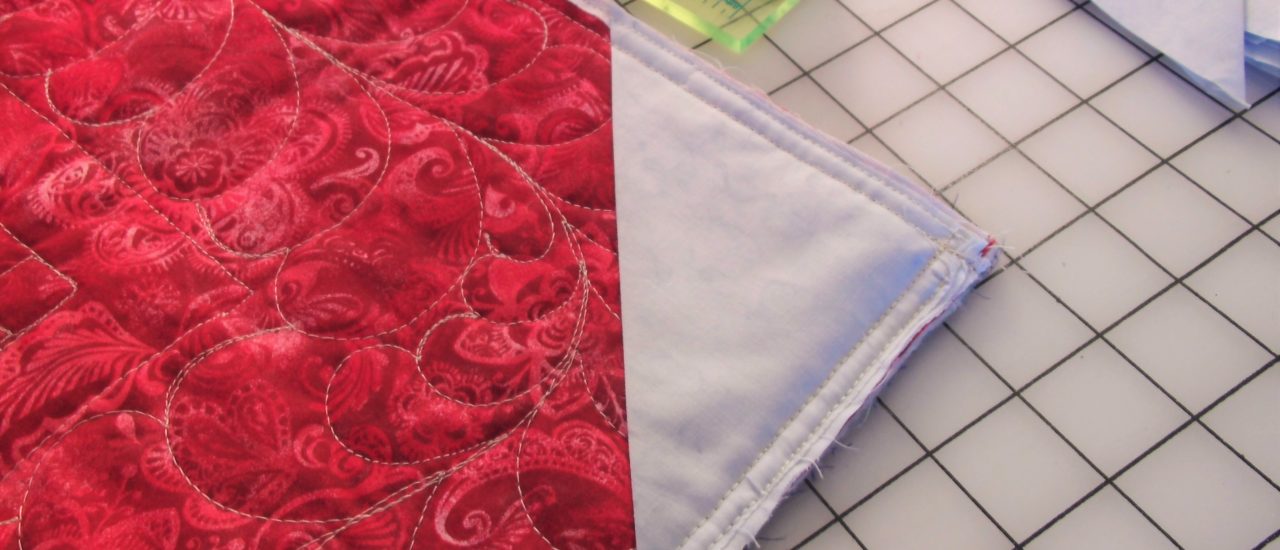
Quilting Tips & Tricks: Quick Labels
A quilt is not finished until it is labeled and signed!
A super easy way to label your quilts is to put in a corner label.
Cut a 5″ square, fold it into a triangle, then sew it into the corner before you attach your binding. Once the binding is complete (folded over and sewn down), then take a permanent marker and write in the quilt name, your name, date and location. Add any special detail if you feel it is appropriate – “wool batting”, “made for 50th wedding anniversary”, etc.
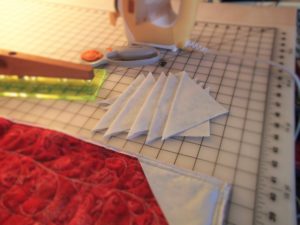
I usually cut a number of 5″ squares and have them ready to go.
NOW you’re finished!
Happy quilting!
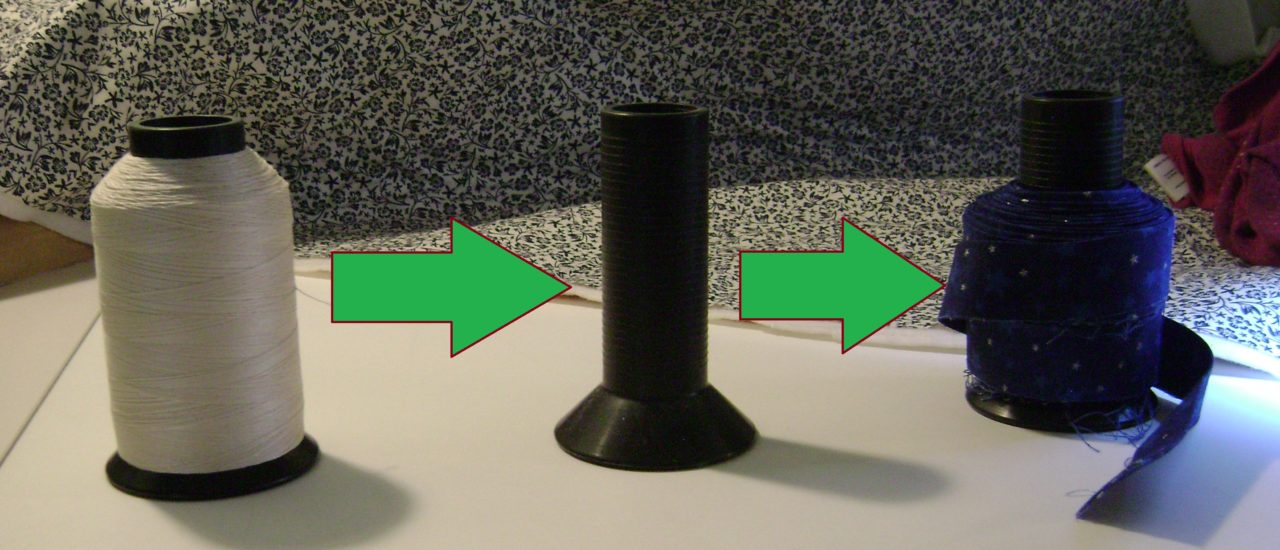
Quilting Tips & Tricks: Organize Your Binding
Here’s a quickie tip for you: keep your binding organized by wrapping it around your old thread cone cores. I go through a lot of thread, so have quite a few cores laying around. You don’t have to use the 2500 yard cones, either. I have lots of 1100 yard cores (they’re cardboard cores, but very sturdy) that I use for holding binding for my smaller projects. For that matter, you could use anything that let’s you wrap the binding neatly – paper towel cores, flashlight handles, anything!
Happy quilting!
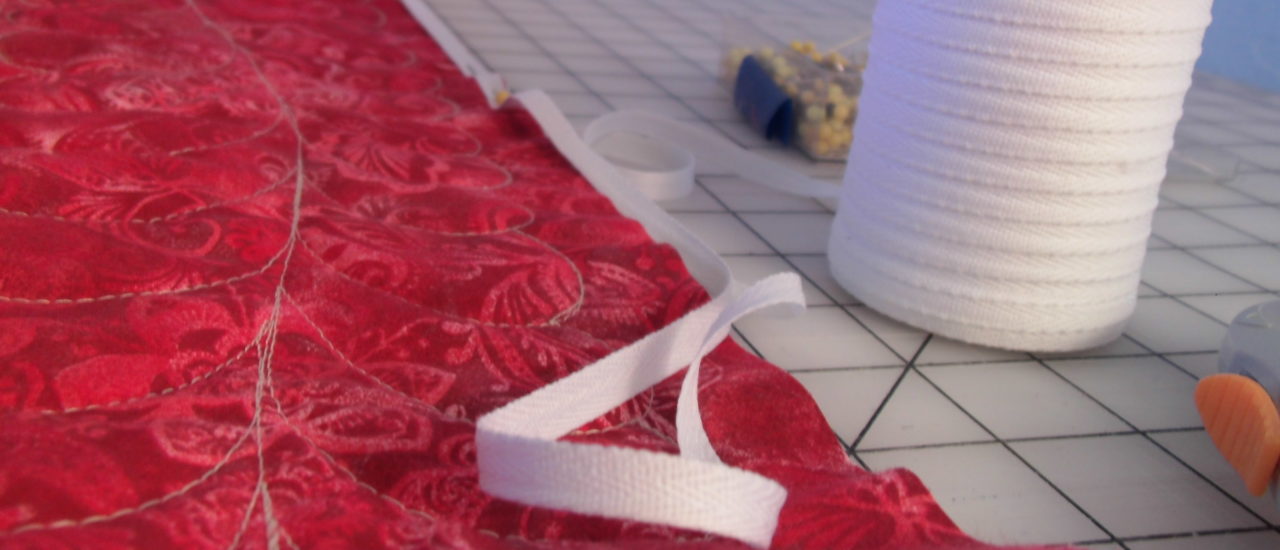
Quilting Tips & Tricks: Stablize Your Edges
I’m betting you, too, have known the heartache of having a perfectly flat quilt top end up with wavy edges because you stretched and pulled too much while adding the binding. I used to just “stay stitch” around the outside edge to stabilize it. But this didn’t really do the trick. And competition judges hate seeing wobbly/wavy edges!
I was in a quilt class taught by David Taylor. He’s fabulous! If you have the opportunity, take a class – any class! – from him. I learned as much from his tips/tricks about quilting as I did about the class topic (which happened to be hand applique). He pointed out that the way he stabilizes the edges of his quilts is to add 1/4″ twill tape.
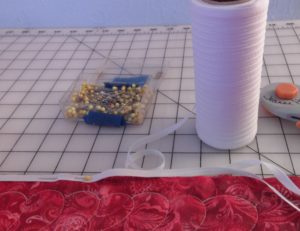
add 1/4″ twill tape to your quilt edges
Twill tape is a solid woven strip that does not stretch. Carefully pin the tape to the edge of your quilt, making sure you do not stretch the edge AT ALL. When you sew through the middle of the tape, it becomes a reinforcement to the edge of your quilt. You always pull your quilt edge a fair amount when adding the binding. This extra step gives your quilts that flat, professional edge that you see on the quilts hanging at shows.
Think about this: if you’re going to sew your binding to the front of the quilt and then fold it to the back, you want to add the twill tape to the back of the quilt. This way, your binding folds over the tape. The reverse is also true: if you intend to sew the binding to the back and fold it to the front, then you’ll want to put the twill tape on the front of the quilt.
I buy my twill tape online in larger quantities. The little packages would be way too expensive to buy even for a single quilt. I mean, suppose you have a queen sized quilt, 78 x 98. That’s almost 10 yards of twill tape for just one quilt. When I buy an 800 yard spool, that’s enough to last even me a couple years.
Happy quilting!
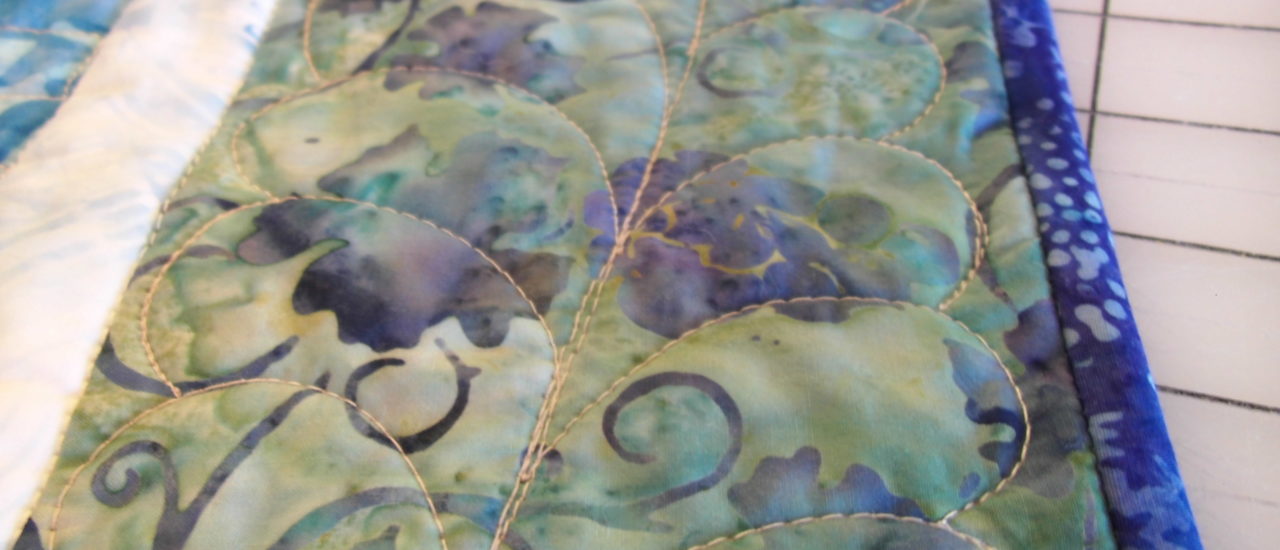
Quilting Tips & Tricks: Stitching the Borders
Whether you quilt for competition, or you just want a quilt that really stands out, you are likely working on customized quilting designs. Some designs are easy to just quilt all over the quilt and through the border. And then you’ve got your highly customized designs where the border has its own customization.
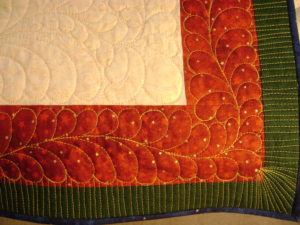
Christmas Pinwheel, 2014
I love quilted feathers! This quilt has special quilting motifs in every section across the entire piece. By the time I finished the rolling feather in the red border, I was tired of quilting and ready to be done with it! I was going to leave the green border empty, but it looked unfinished. So I decided to fill the outer border with a design that could easily flow into the binding.
But suppose you want to put feathers or some other design in your outer border? You don’t want the edges of the feathers to be cut off by the binding. What is the best way to mark/measure your quilt top so that your design fills the space without running the risk of flowing into the binding?
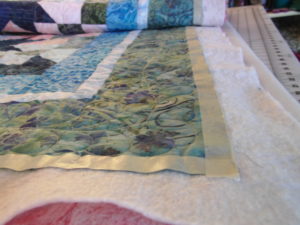
1/2″ masking tape on the edge to guide quilting
I put 1/2″ masking tape all around the edge of the quilt. I can sew my design right up to the edge of the tape. I know that when I trim the quilted top, I won’t take off more than a 1/4″. And then I want to allow a 1/4″ for the binding. So a 1/2″ masking tape is perfect!
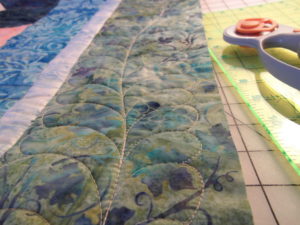
quilt trimmed and my feather has plenty of room
You can see that there is ample room for the binding and no risk of clipping the curves off my feathers.

Feathers intact with finished binding
So don’t avoid those specialized border quilting designs. And don’t worry about a bunch of math or trying to mark your top. The masking tape goes on easily and comes off quickly.
You’re close to finishing your quilt!
By the way – quilt judges love customized quilt designs. Just sayin’.
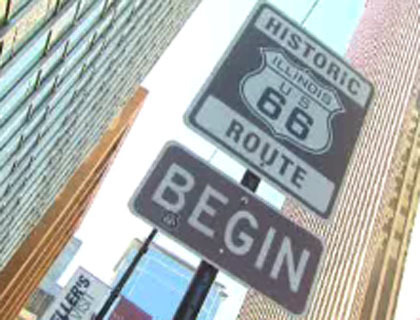
Route 66: 7 Things to Pack, or Leave Behind
I’m actually writing this mostly for the benefit of any neighbors who will be visiting from other countries. My fellow Americans will probably read through this and give me a big, “Duh!” (That’s American for, “That’s so obvious, why do you even mention it?”) But having traveled through the UK, France, Jamaica and Africa, plus countless road trips across the US, I may have a few observations that could be helpful for folks visiting the US for the first time.
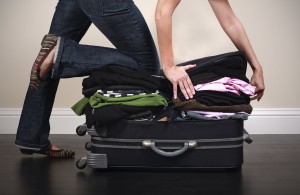
photo borrowed from lostintransit.org
1. Keep some perspective
First of all, keep in mind that you are not visiting a 3rd world country. The US has anything you could possibly need – and quite a few things you had no idea existed. Granted, you may be coming from the UK and you know for a fact that nowhere in the US is your preferred brand of biscuit. I promise, you’ll survive. But as you pack, relax! You’re going on vacation. If you forget your toothbrush or batteries or the special electric plug converter combo set that you bought especially for this trip – don’t worry about it. It’ll all work out.
At the end of the day, all you really need is
your identification, your credit card, and your spirit of adventure.
2. Don’t take what you can’t bear to lose
In the movie, “The Accidental Tourist“, the main character suggests that when traveling, never pack anything that cannot be left behind in an emergency. This is not bad advice. It goes along with keeping your perspective. Accidents will happen, luggage may be lost, or anything else could happen that may cause you to lose the items you brought along. Hopefully, if you were to lose your luggage, you can treat it as an annoyance rather than a heartbreak.
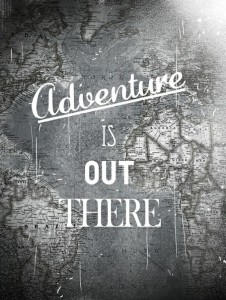
3. Personal Necessities
Even allowing that you can get virtually anything in the US that you have back home, there are still some things which need to be brought along. I’m thinking about your prescription medicine, special vitamins, or even your favorite skin lotion. Medicines, in particular, are highly regulated in the US and may be very difficult to obtain.
When flying, always carry your prescription medication in your carry-on.
As you go through your morning and evening routines, take note of the sundries you use. From your hairbrush to your toothbrush, your makeup, your morning meds and vitamins – consider carefully what you use each day. You’ll want to pack these.
And consider items like reading glasses and sunglasses – bring an extra pair. Put one set in your carry on, the other in your suitcase.
4. Clothing for Route 66
It was in May, 2008 that I visited Zambia, Africa. They had just finished their hot, wet season and I was coming from our cold, wet season. That is, they’d had up to 120 degree weather (48 Celsius) and I’d had freezing 20 degree (-6 Celsius) weather. As you can imagine, I was really enjoying the warm mornings at about 75 degrees (24 Celsius). One of the ladies who worked at the orphanage came around in a heavy sweater, concerned that I might be cold in my sleeveless shirt.
“You didn’t know it would be this cold in Africa, did you?” she asked.
So every place is relative when you start talking about hot weather and cold weather. When you drive the length of Route 66, you are crossing 3 time zones and numerous weather climates. This Route 66 site has some pretty neat info on weather along the Route. Depending on the time of year, you could go from cold and rainy to hot and dry in the space of a day. You need to have appropriate clothes for all possibilities.
Chances are that you aren’t driving the route in the winter, so you don’t need to haul along the cold weather gear. But if you’re from a very warm region, then the cooler temperatures on some parts of the drive may be uncomfortable for you. The opposite is also true: if you come from a cooler clime, the dessert heat may hit you like a hammer. Plus, rain can be expected all year.
The answer? Layers! Have a couple light-weight outfits for warm weather, with some overshirts, and a light jacket or sweater. Bring along a cheap, plastic rain poncho – like you’d use for camping – and plan on throwing it away when the trip is done. Comfortable shoes are a must! But you’re not going to a fashion show – minimize the footwear.
We’re pretty casual in the US, and we don’t expect travelers to dress formally.
Still, you may want to have one “Sunday-go-to-meetin'” outfit.
Personally, I am going to pack about a week’s worth of clothing for my 3 week drive. Almost every town will have a laundromat available – most motels will likely have washing machines and dryers that you can use for a small price, or possibly a laundry service. Airline luggage weight limits are crazy these days! Pack as little as you can for the trip out so that you have room for your treasures on the way home.
5. Practical Stuff
On a long road trip, there are certain things you need to keep in the car as a matter of necessity:
- A case of water – doesn’t have to be chilled, but have water (not just soda) in case you get stranded or come across a stranded motorist who needs water.
- Toilet Paper – there are plenty of rest stops on the road. They aren’t all stocked well with toilet paper. Just sayin’.
- A warm blanket – the nights get cool in the desert.
- First Aid Kit – doesn’t have to be elaborate, but have some bandaids and antiseptic on hand.
- Contacts – have a friend back home that you text or email every day to let them know where you are, where you’ve been. This is especially important if you are traveling alone. If you don’t check in, your friend will know to make inquiries.
6. Electronics
We have lots of electronics nowadays. These days we have electronic devices to help us manage our electronic devices. Laptop, iPod, iPhone/Android, kindle, cameras… There is so much that we use on a daily basis. But let’s consider a couple things:
Are these really necessary? If I were leaving the country, I’d leave my laptop and ipod at home. I’m visiting a new place, seeing new sights, meeting new people! Most electronics will distract me and separate me from the experience. An “I”-pod is not a “we”-pod – it doesn’t make new friendships with others. And unless your cell phone is your camera, you’re on vacation! Put the phone away. Reconnect with the human race.
I will give one caveat here: bring the cell phone, but pack it away. Better yet, leave your fancy cell phone at home and buy a “burner phone” when you arrive. It’s cheap, it works on the local mobile system, and you can throw it away at the end of your trip. If you break down on the road, get lost, have trouble of any sort – you’ll want to have a cell phone for easy communications.
What if these things are lost? Remember the rule above – don’t take what you can’t bear to lose. I’ll be backing up my computer and cell phone before I leave home. If I lose the electronics, at least I won’t lose the data.
So why am I bringing it? I plan on blogging frequently while I’m on the road (shameless plug to get you to visit me again!) and I’ll be downloading my pictures daily. My car is 15 years old (seriously! 15 years old!) and doesn’t have a great radio, so I plug in my ipod to listen to my tunes while I’m driving. (Yes, I am that person who rolls down the windows and sings along with the music at the top of my lungs.) And, finally, reading my kindle at night helps me relax before going to sleep. So I have enough excuses to warrant bringing all this stuff with me.
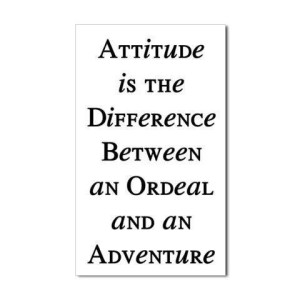
7. An Attitude for Adventure
I’ve had folks tell me some pretty harrowing stories about events that happened on road trips – from flat tires, to flash floods, to getting lost and finding yourself in a town that you are pretty sure breeds serial killers. But none of that has ever happened to me. Well, I’ve had flat tires – and gotten to meet some really nice people who pulled over to help me! And, well, I was in a flash flood once – which made for a great story at the next family dinner! But I’ve never gotten lost. Well, except for that time I missed the interstate and decided to drive back roads across two states and got to see some of the most beautiful country God has placed on this earth!
Route 66 is a Grand Adventure! This is the road trip to end all road trips! Let go of all your preconceived notions and just let the experience happen. I’m looking forward to telling you all about the amazing people and places as I wander through my favorite country in the world!
See you soon!

Basting Your Quilt Top
There are any number of ways to keep your sandwich from shifting. For some smaller pieces, you may not need to do any basting at all – just layer it up and start quilting from the middle out. Early in my quilting, I used to use safety pins. If you do a google search on basting methods, you’ll see quite a few different methods available.
My preference is to use basting spray.
I have a spray that I tend to buy as much as possible whenever it goes on sale, 2-3 times a year. It’s not unusual to see 20 cans on my shelf – I’ll use them all in the course of a year! I make that many quilts. Different people are very loyal to specific brands. I am loyal to my budget.
What you’ll need:
- Top, batting and backing, ready for layering
- A place to lay your quilt out flat – well ventilated!
- Masking tape
- 1-2 cans basting spray (depending on the size of can and size of quilt)
- Scissors
Top, batting and backing – ready for layering
Make sure your quilt top is pressed and completed. Remove as many loose threads as you can while you are ironing.
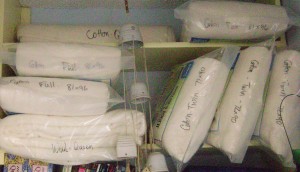
I’m partial to cotton batts. They are a little more expensive than polyester, but they breathe better than poly and I can iron my completed quilt (to remove fold lines). Never iron a quilt with a polyester batt – you’ll melt the batting. There is a “fusible batt” available which is the exception to this, but I found the fusible batt to be more bother than help, so I don’t use it. Depending on what you are accomplishing in your quilt, there are also wool batts, silk batts, and various mixes of cotton/wool/silk/poly.
I have used bamboo batting – I love how soft it is and it’s easy to work with. But I have since learned that the process to make tough bamboo fibers into soft fabric/batting is very eco-UNfriendly. Lots of nasty chemical waste. I don’t use bamboo any more.
Aaaaand the backing. I love the extra-wide fabrics available for backing these days. Although, you can make some pretty cool pieced backings, too. Whatever you choose, have it pressed and ready to lay it out. It doesn’t need to be totally wrinkle free like a dress shirt, but you do want to remove the major creases. Once you’ve basted your sandwich, any creases will be part of your quilt.
A place to lay out your quilt
I do not have enough floor space at my home to lay out my quilts, even if I move the furniture around. So I use the cafeteria at my office. They have lots of tables that I can push together for a work space, no one is there after the regular work day, and it’s a huge, airy room with great ventilation.
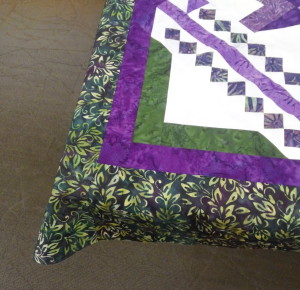
This table is too small.
Today’s blog was inspired by my having two queen sized quilt tops that I needed to baste. After my regular day at the office, I headed down to the cafeteria and pushed together four tables. This is usually enough for my full sized or smaller quilts. But not the queens! You really want to have a space that the entire quilt top can lay flat and smooth. But if I put too many tables together, I can’t reach into the middle of the quilt.
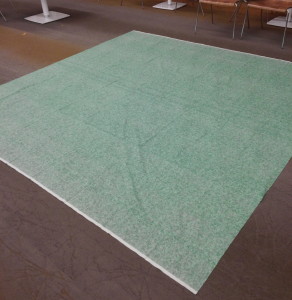
Laying out on the floor?
So, I thought, let’s just lay it out on the floor. I’ll have to be careful when spraying so that I don’t get adhesive spray on the carpet, but this will be fine. Um. No. As I stood there staring at my backing on the floor, I could just feel the inevitable bruises on my knees. Nope – I’ll figure out a way to reach the middle of the quilt after I push together more tables.
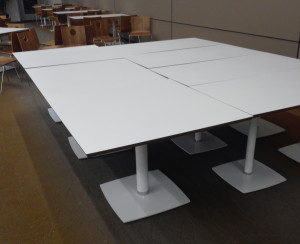
This will work! So the first step is to lay out the backing on the table, wrong side up.
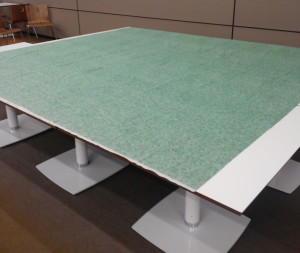
I use blue painter’s masking tape to give a slight stretch to the backing and hold it down.
As a note, different masking tapes have different amounts of sticky on them. The blue tape has a little less sticky, which is why painters use it. It is not likely to leave any residue on your fabric.
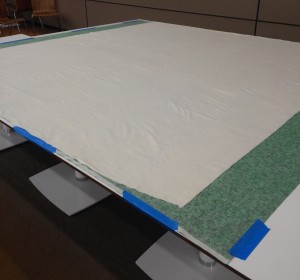
backing wrong side up, batting layered on top
Next unfold your batting on top of the backing. Gently smooth it out, patting it down to eliminate folds. You do not need to iron your batting.
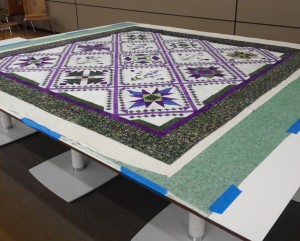
Finally, lay the quilt top, right side up, on top of the batting. You now have a quilt sandwich!
This is about the only time that I am able to look over my quilt top laying flat like this. I’m going to take a moment to consider what quilting design/pattern I want to stitch in. I’m also going to look for any particular faults that will affect my quilting…
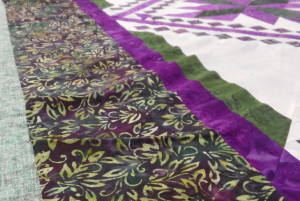
And I can see that I have got some serious wobbles in this border! Now, if this were a competition quilt, I would stop right here, take it home, and re-work the border. But this particular quilt is not being made for competition – it’s a block-of-the-month from a local quilt shop. Since it’s a “kit” quilt, I can’t show it at any national show. This entire quilt is intended as practice to improve my skills. Also, I happen to know that I messed up some of the piecing in the seminole sections of the blocks, so I am making an executive decision to just “quilt out” the border wobbles.
“Don’t let perfection be the enemy of good!”
This is a beautiful quilt. I love the colors and fabric, there is plenty to look at with all the different blocks, and, really, it’s come together very nicely. I will likely be the only person who ever notices that my borders have a wobble or that some points have been cut off. I shall continue on and finish!
Carefully fold back about half the quilt top to expose the batting. Spray your adhesive, following the directions on the can, onto the batting. Then carefully lay the quilt top back down on top of the sticky batt. You may want to spray 1/3 or 1/4 at a time. As you lay the top down, gently smooth it down from the center out. No wrinkles allowed! This is why I was concerned about the table being so deep that I cannot reach the center. For tonight, I used my coat to swat down the center area that I couldn’t reach. When I got to my wobbly borders, I did some gentle pulling and adjusting and smoothing to minimize wrinkles.
One of these days I’m going to invent a gadget that will allow quilters to easily baste a big ol’ turkey of a quilt top, but will fold up and store out of sight.
I’m going to call it,”The Turkey Baster”.
After you have adhered the top to the batting, you’ll repeat the process by folding back the top/batt and spraying the backing. This step goes a little faster since you aren’t adjusting the top any more. Still smooth it down from the center out.
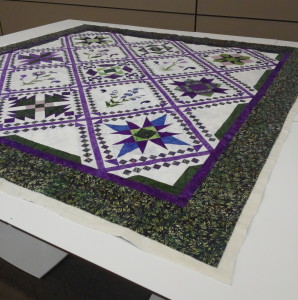
My final step is to trim away the excess batting and backing to within a couple inches of the quilt top. This isn’t necessary, but, hey, I was taking pictures for posterity and thought it looked neater. The wobbles are hardly noticeable now.
On to the second quilt of the night!
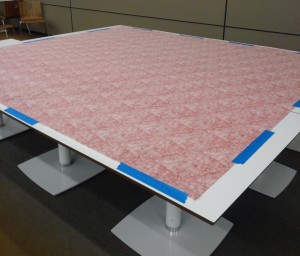
Backing taped down.
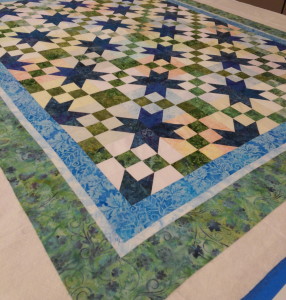
Layer it up.
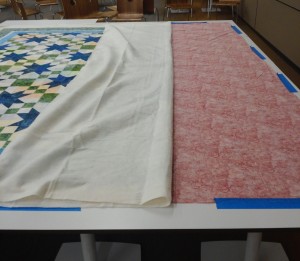
This time I got a picture when I was folding it back for spraying.
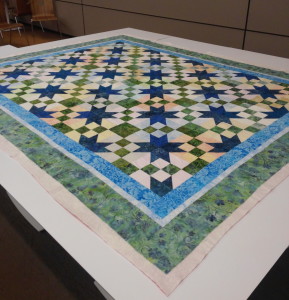
And now I have a trimmed, basted quilt sandwich. This is a very traditional quilt pattern. I am pleased with how it is looking so far. I will likely show this one at the local county fair this coming July.
The last step of basting is to return the cafeteria to its previous state – or better. I generally wash down the tables so that I don’t leave behind any stickiness from the spray.
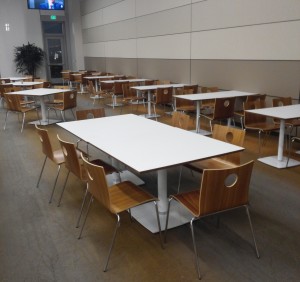
Always leave a space neat and tidy.
Check back to see these quilts when they are finished! They should be all done within a few weeks.
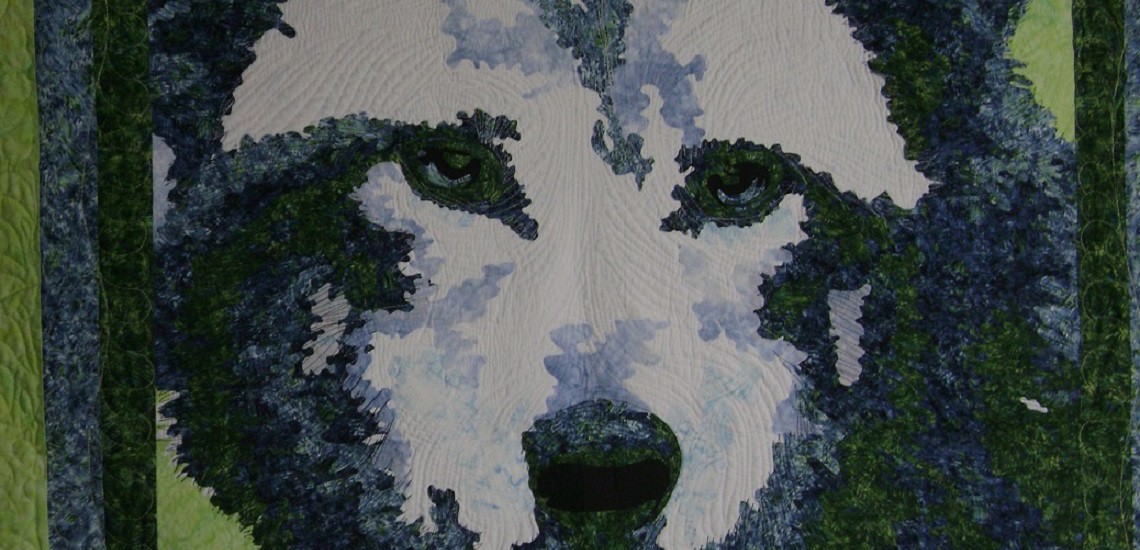
Life Lessons in Quilting
I wasn’t always a quilter.
In the late 80’s I was in my early 20’s and I was proud to be a Modern Woman. Yes, I was an 80’s Lady! I didn’t cook and I didn’t sew – I didn’t do any of those old fashioned things that kept women tied down and locked into out-dated roles. I was free!
Or, I thought I was free. In fact, I was enslaved to a different set of roles and expectations, the new rules of society that demanded that I conform to their expectations. And society did not make me happy or fulfilled.
But when God reached down and changed my heart, suddenly I found true freedom! I discovered that when I follow His handbook for living (the Bible) then I am both happy and fulfilled. No, it’s not a set of rules that I must follow or be cast to the outer darkness. It is a relationship with a living God who wants to watch over me and protect me, who wants me to enjoy life. What a thought – God wants me to be happy!
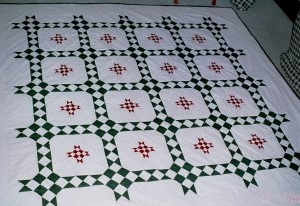
Criss Cross; 2000
My First Quilt
So it happens that in 1992, not long after Jesus changed my life forever, that I woke one morning and decided I wanted to do something I’d never done before: I wanted to make a quilt! I drew out a sketch of the quilt I wanted, then figured out the math of how much fabric yardage was needed. Next I pulled out my Craftsman retractable measuring tape, a marking pen, and a pair of scissors. My first quilt, which I am NOT posting here, was a very simple design I called “X Marks the Spot”.
I had no idea what I was doing. After I’d sewn the top, I put a border on it and then stenciled in a leaf and vine design. Yes, stenciled. It was the 90’s. I didn’t know how to put a backing on the quilt or how to “stuff” it with the batting, so I bought a book (one of Eleanor Burns’ early “Quilt in a Day” books) and finally got it all done – lumpy corners, uneven edges, very little actual quilting. It was beautiful! I felt so much accomplishment in that project as I never had before! I was hooked!
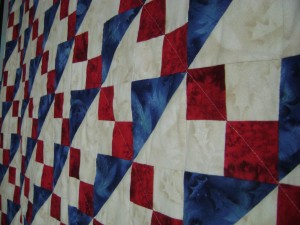
American Ladder; 2009
I have photos of my early quilts, but they aren’t very good photos. Perhaps one day I shall post them anyway.
With every quilt I got more practice. My piecework improved so that corners were matching and I wasn’t cutting the tips off my triangles. I found that if I cut accurately, and sewed accurately, I got really great results! I started buying all the specialty quilting tools to help improve my technical skills.
Most quilts I made were given as wedding gifts and baby gifts. And then I became hooked on a whole new benefit of quilting: seeing a person’s joy and excitement in that moment that they realize they are receiving a quilt! This is one of the best parts of quilting for me!
There are 3 steps to making a quilt:
The Planning * The Making * The Giving
I also wanted to do a little fancier stitching on my quilts. I started drawing designs on the quilts and practicing free-motion quilting. The below “Celtic Wheel” was one of my early free-motion quilts.
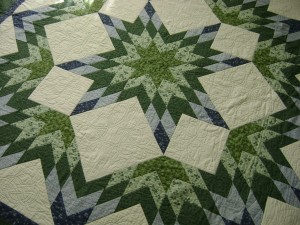
Celtic Wheel; 2011
Competition
In 2012, I was chatting with a dear friend who commented that she was thinking about showing some of her photography at the local County Fair that year. This got me thinking about showing a couple of my quilts. I mean, why not? I make pretty quilts – everyone says so. Let’s see if I might bring home a ribbon or two.
I chose two of my recently completed quilts and brought them in. I even took time off work so that I could listen to the judge make her comments.
So here’s how it works: you enter your quilt in a specific category so that quilts can be judged against similar quilts. For example, one category may be “machine pieced, machine quilted, large” and another category may be “hand applique, hand quilted, small”. The judge examines each quilt in a given category, having a scribe write her notes. Many competitions will have list of items being evaluated: technical (corners matching, points sharp, borders even, etc) and artistic (colors well balanced, uniform quilting, overall pleasing appearance). The quilts for each category are stacked on a table so the judge may examine them one by one. She then goes down the list having her scribe underline items that are well done and circling items that need improvement. Within each category, the judge then chooses first (blue), second (red) and third (white) place ribbons. The County Fairs often give a small cash prize for the ribbons ($2 for blue, for example). Major competitions may give larger cash prizes or prize packages (sewing machines, books, fabric, etc).
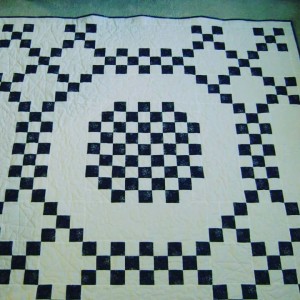
American 9-Patch, 2012
My first judged quilt, pictured above, was in a category with about 15 other quilts. The other quilts were pretty amazing, but my simple design was very pretty in its own right so I was eager to listen and learn. The judge came to my quilt and started issuing comments to her scribe: Circle “corners square”. Circle “straight edges”. Circle “even stitches”. (Remember, “circle” means “needs improvement”!) Circle. Circle. Circle. At this point, I was extremely pleased that we in the audience are required to remain silent so that the judge does not know who made one quilt or another. I was cringing with every new item to be circled. Finally she came to the end and had her helpers hold up the quilt so that she could stand back and look at it from a short distance.
And then the judge said, “Now THAT is a pretty quilt!”
Suddenly I was no longer cringing! I was sitting up – mine is a pretty quilt! In spite of all its faults, it was pleasing to look upon and it would serve its function well. The rest – the ninety degree corners and even borders and all the rest – that was all technical stuff that I could learn and improve upon. I bought the little booklet that listed out the standards that the judges were looking for. Now that I had the standard, I could bring my quilts to the next level!
A Life Lesson
I would like to pause and comment that this lesson I learned in quilting was so profound that I have applied it to all of life. Whenever I start feeling terribly pleased with myself, I stop and ask, to what am I comparing? What is my standard? Why do I consider myself to be a pretty good person? Is that compared to the convict serving time? Or am I “pretty good” compared to Jesus, my ultimate example? There is a standard to which I have not yet attained in life. My God is helping me to improve, but it’s a long, long project!
I ask myself: “What is my standard?”
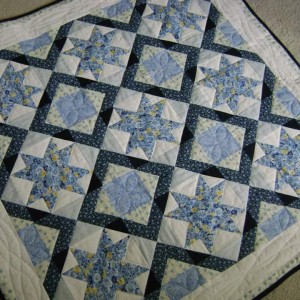
2012 Baby Quilt – 2nd Place at the County Fair
That first year at the County Fair, the quilt I described above did not win a ribbon. The other quilt I showed won a 2nd place ribbon, but only because I’d entered it in the wrong category and it happened to be marginally better than one of the other quilts in the same category. The following year I won several second and third place ribbons. Last year, 2015, each of the quilts I entered won 1st place in their categories – and I even won a ribbon for having won the most blue ribbons! I’ve also shown a couple quilts in national shows (no ribbons) and one of my quilts won a “best first time entrant” award at the Colorado State Fair in 2014 – Mr. Orange is my nod to the Broncos.
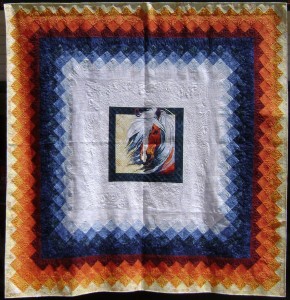
Mr. Orange; 2014
But still improvement is needed – I have not yet won a “Best In Show” at the County Fair, nor have I ribbon’ed at a major competition.
Quilting is an Expensive Habit
These days I am constantly working on my piecing and quilting skills. I have been blessed to obtain a “mid-arm” quilting machine. This has a good 16″ from needle to motor so I have plenty of space to quilt down the big quilts! Though it has a computer display, it is not digitized – all my quilting is guided by my own hand.
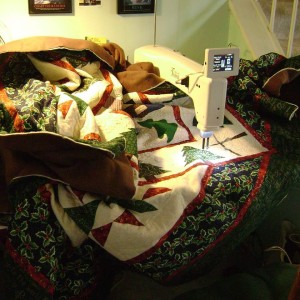
I also tried my hand at carpentry this last year and built myself a proper work table:
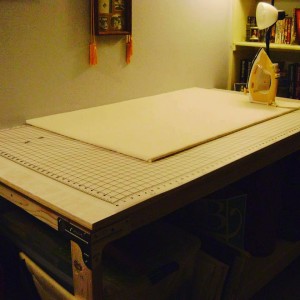
Yeah. I’m not doing that again. But I’m glad I had the experience of making it. And there always seems to be more tools, more rulers, more cutting devices and, of course MORE FABRIC!! I am limited only by my own imagination. And budget.
So I invite you to come along on this journey with me as I seek to improve my quilting skills, and my life skills. Quilting makes me happy – which I know pleases God. And I seek to serve God by serving His people with quilting and cooking and more. What is my standard? There is always more that could be done, if done in love.
Please visit my gallery to view a few of my quilts. I’ll be adding to the gallery periodically. I hope you enjoy!

